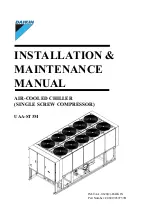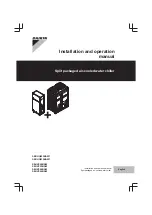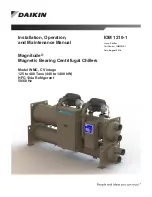
TAEevo M05-M10
9
MAINTENANCE AND OPERATING MANUAL
The data inside this manual are not binding and they can be modified by the manufacturer without notice.
All rights reserved.
A pressure gauge is connected to the pump output. It indicates the outlet water pressure of the plant.
4.4.2 Refrigerant circuit
The refrigerant is pumped by the refrigerant compressor to the condenser. The condenser is a heat exchanger and is cooled by an air flow
produced by a fan.
After the condenser, the refrigerant liquid passes through a drying filter and a laminating element (capillary tube).
The refrigerant then enters the evaporator’s circuit in which it flows in counter-current with respect to the water to be cooled.
When it exits the evaporator, the refrigerant is again sucked by the compressor and the cycle repeats itself.
The refrigerant circuit is also furnished with a high pressure switch (HP) of manual reset type.
4 . 5 E l e c t r i c a l c i r c u i t
See the enclosed electrical diagrams.
C
HAPTER
5
I
NSTALLATION
ATTENTION
Before carrying out the installation or operating on this machine, ensure that all the personnel has read and understood the
“Safety”
chapter
in this manual.
5 . 1 I n s p e c t i o n
Immediately after uncrating, inspect the unit.
5 . 2 P o s i t i o n i n g
1.
The
chille
r must be installed indoors only.
2.
The room must be well ventilated. In some cases it may be necessary to install fans or extractors to limit the temperature of the
room.
3.
The ambient air must be clean and not contain flammable gas or solvents. The minimum and maximum working ambient
temperatures are specified on the unit data plate. In extreme temperature conditions, the protection devices may trip.
4.
The machine can be positioned on any flat surface capable of supporting its weight.
5.
Leave at least one metre in front of the unit to permit access during service operations (see chapter
4.2 “Overall dimensions”
).
6.
Do not obstruct or disturb the condenser's flow of cooling air.
Position the
chille
r in such a way that the cooling air cannot
recirculate in the intake grilles.
Ensure that the
chille
r is not subject to warm air from the cooling systems of other machines.
5 . 3 A n t i f r e e z e p r o t e c t i o n
Even if the minimum working ambient temperature is above 0°C it is possible for the
chille
r - during stoppages in the cold seasons - to find
itself in an environment with a temperature below 0°C. In these cases, if the
chille
r is not emptied, antifreeze (ethylene glycol) must be
added in the following percentages to prevent the formation of ice:
According to the outlet temperature of cooled water, it is necessary to add the following antifreeze (ethylene glycol) percentages in order to
avoid freezing:
Ambient temperature
up to [°C]
Ethylene Glycol
[% in weight]
0
0
-5
15
-10
25
-15
30
-20
40
Water outlet minimum
temperature [°C]
Ethylene Glycol
[% in weight]
0<T
15










































